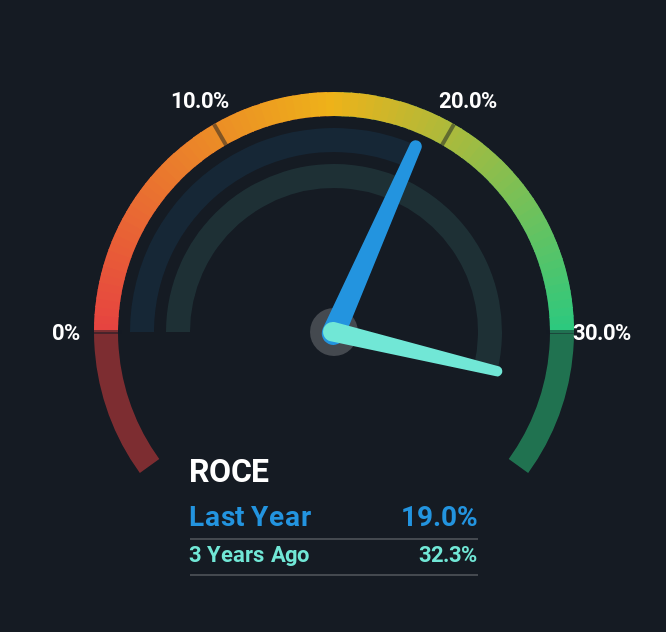- India
- /
- Commercial Services
- /
- NSEI:IONEXCHANG
Ion Exchange (India) (NSE:IONEXCHANG) Will Be Hoping To Turn Its Returns On Capital Around
If you're not sure where to start when looking for the next multi-bagger, there are a few key trends you should keep an eye out for. Ideally, a business will show two trends; firstly a growing return on capital employed (ROCE) and secondly, an increasing amount of capital employed. Basically this means that a company has profitable initiatives that it can continue to reinvest in, which is a trait of a compounding machine. Although, when we looked at Ion Exchange (India) (NSE:IONEXCHANG), it didn't seem to tick all of these boxes.
What Is Return On Capital Employed (ROCE)?
Just to clarify if you're unsure, ROCE is a metric for evaluating how much pre-tax income (in percentage terms) a company earns on the capital invested in its business. To calculate this metric for Ion Exchange (India), this is the formula:
Return on Capital Employed = Earnings Before Interest and Tax (EBIT) ÷ (Total Assets - Current Liabilities)
0.19 = ₹2.5b ÷ (₹26b - ₹13b) (Based on the trailing twelve months to March 2025).
Thus, Ion Exchange (India) has an ROCE of 19%. In absolute terms, that's a pretty normal return, and it's somewhat close to the Commercial Services industry average of 17%.
View our latest analysis for Ion Exchange (India)

Historical performance is a great place to start when researching a stock so above you can see the gauge for Ion Exchange (India)'s ROCE against it's prior returns. If you want to delve into the historical earnings , check out these free graphs detailing revenue and cash flow performance of Ion Exchange (India).
What Does the ROCE Trend For Ion Exchange (India) Tell Us?
In terms of Ion Exchange (India)'s historical ROCE movements, the trend isn't fantastic. Around five years ago the returns on capital were 32%, but since then they've fallen to 19%. Although, given both revenue and the amount of assets employed in the business have increased, it could suggest the company is investing in growth, and the extra capital has led to a short-term reduction in ROCE. If these investments prove successful, this can bode very well for long term stock performance.
On a related note, Ion Exchange (India) has decreased its current liabilities to 50% of total assets. That could partly explain why the ROCE has dropped. What's more, this can reduce some aspects of risk to the business because now the company's suppliers or short-term creditors are funding less of its operations. Since the business is basically funding more of its operations with it's own money, you could argue this has made the business less efficient at generating ROCE. Keep in mind 50% is still pretty high, so those risks are still somewhat prevalent.
The Key Takeaway
In summary, despite lower returns in the short term, we're encouraged to see that Ion Exchange (India) is reinvesting for growth and has higher sales as a result. And the stock has done incredibly well with a 167% return over the last three years, so long term investors are no doubt ecstatic with that result. So while the underlying trends could already be accounted for by investors, we still think this stock is worth looking into further.
Since virtually every company faces some risks, it's worth knowing what they are, and we've spotted 2 warning signs for Ion Exchange (India) (of which 1 can't be ignored!) that you should know about.
While Ion Exchange (India) may not currently earn the highest returns, we've compiled a list of companies that currently earn more than 25% return on equity. Check out this free list here.
New: AI Stock Screener & Alerts
Our new AI Stock Screener scans the market every day to uncover opportunities.
• Dividend Powerhouses (3%+ Yield)
• Undervalued Small Caps with Insider Buying
• High growth Tech and AI Companies
Or build your own from over 50 metrics.
Have feedback on this article? Concerned about the content? Get in touch with us directly. Alternatively, email editorial-team (at) simplywallst.com.
This article by Simply Wall St is general in nature. We provide commentary based on historical data and analyst forecasts only using an unbiased methodology and our articles are not intended to be financial advice. It does not constitute a recommendation to buy or sell any stock, and does not take account of your objectives, or your financial situation. We aim to bring you long-term focused analysis driven by fundamental data. Note that our analysis may not factor in the latest price-sensitive company announcements or qualitative material. Simply Wall St has no position in any stocks mentioned.
About NSEI:IONEXCHANG
Ion Exchange (India)
Provides water and environmental management solutions in India and internationally.
Adequate balance sheet average dividend payer.
Similar Companies
Market Insights
Community Narratives


Recently Updated Narratives


Alphabet: The Under-appreciated Compounder Hiding in Plain Sight


MINISO's fair value is projected at 26.69 with an anticipated PE ratio shift of 20x


The Quiet Giant That Became AI’s Power Grid
Popular Narratives


The company that turned a verb into a global necessity and basically runs the modern internet, digital ads, smartphones, maps, and AI.


MicroVision will explode future revenue by 380.37% with a vision towards success



